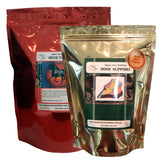Feeding the hoof: minerals
 In this third and final part of 'Feeding the Hoof' we shall look at the role minerals play in healthy hoof tissue. Minerals are often referred to as 'major' and 'trace', which isn't a differentiation of importance, rather quantity. Major minerals are required in gram amounts, whilst trace minerals are required in milligram amounts. Four minerals in particular affect the hoof: sulphur, zinc, copper and selenium.
In this third and final part of 'Feeding the Hoof' we shall look at the role minerals play in healthy hoof tissue. Minerals are often referred to as 'major' and 'trace', which isn't a differentiation of importance, rather quantity. Major minerals are required in gram amounts, whilst trace minerals are required in milligram amounts. Four minerals in particular affect the hoof: sulphur, zinc, copper and selenium.
Sulphur is a major mineral and makes up about 0.15% of total equine body weight in the form of sulphur containing amino acids, the B vitamins thiamine and biotin, heparin, insulin and condroitin sulphate. Horses must meet their sulphur requirements through organic sulphur found in the amino acids in plant proteins, such as cystine and methionine. These two sulphur containing amino acids play a major role in almost all proteins and enzymes in the body. In relation to hoof tissue, keratin is rich in sulphur, and sulphur is also necessary to form the reinforcing bonds between strands of collagen. Collagen is the base of all connective tissues in the body including hooves, bones, joint cartilage, tendons and ligaments. That bad egg smell you get if you burn hair, that's the sulphur in the keratin going up in smoke!
Zinc may only be required in trace amounts, but it is present in the body as a component of more than 100 enzymes. One such enzyme is the antioxidant superoxide dismutase. This is present in hoof tissue and functions to prevent the fats and oils in hoof tissue from oxidising. Oxidative damage to the fats can break the protective seal on the hoof, causing over drying, and weakening the 'glue' between keratin cells. In normal hoof tissue zinc is present in high concentration. It is incorporated into “zinc finger” proteins required for cell multiplication and for the assembly of keratin, the major structural protein of the hoof. It is little surprising that symptoms of zinc deficiency in the diet often show in the hoof with slow growth, thin walls, weak connections and weak horn.
Copper is another trace mineral essential to good health. It too is part of the antioxidant enzyme superoxide dismutase, found in hoof tissue. It is also part of enzymes required for aerobic metabolism in rapidly dividing cells and for the activation of the enzyme which forms the sulphur cross bridges that hold keratin strands together. Osteochondrosis (a disease of the junction between cartilage and bone in joints) has been reported to be associated with copper deficiency.
The final trace mineral we shall look at, selenium, is only required in miniscule amounts. The National Research Council of America's 'Nutrient Requirements for Horses' recommended intake is 0.1 ppm (parts per million) in the diet, or 1mg per day for a 500kg horse at maintenance rate. Selenium is a potent antioxidant and can contribute to hoof health through its incorporation into the enzyme glutathione peroxidase, an important antioxidant for protecting fats. However too much selenium is toxic to the horse, and can result in death. Excessive selenium negatively impacts the hoof, weakening the protein structure of the hoof by substituting for sulphur. One of the characteristics of chronic selenium toxicity is foot pain and cracking of the hooves around the coronary band which can progress to the sloughing of the entire hoof. Just because a little is good, a lot is definitely not better!
Feeding the hoof is quite complex, and we have looked at how the key components of amino acids, vitamins and minerals are utilised by the body to build strong hoof tissue. Because it is so metabolically active, deficiencies in these key groups will show in the hoof, but identifying the exact compound is extremely difficult, as many also interact with one another. For example, the limiting essential amino acid methionine is also a key source of the mineral sulphur; vitamin B6 is used to synthesise the non essential amino acids alanine and glycine, which are two of the key building blocks of keratin, the major structural protein of the hoof; both copper and zinc are needed to produce the fat protecting antioxidant enzyme superoxide dismutase, but if the quantities of these minerals are not in balance, uptake by the body is detrimentally affected.
And just as one trim will not solve a major imbalance issue, supplementing for healthy hoof growth takes time. 30 days of supplementation will not give you a brilliant whole hoof capsule, but it will improve the 6-10mm of new hoof growth put down during that time.
In all my dealings with horses a critical requirement I find I need is patience: in schooling, in conditioning, in trimming. Feeding to grow a strong hoof is just the same.
|
RELATED PRODUCTS |
|||
 |
 |
 |
 |
| Hoof Support |
Hoof Builder |
Omega-3 | Laminitis Recovery |